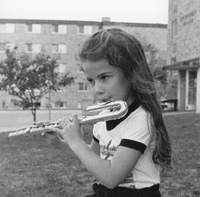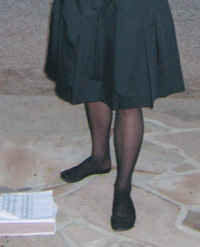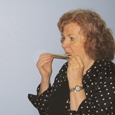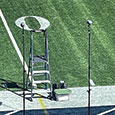When a clinician asked a student why she played the flute, the student hesitated for a moment. The clinician leaned over and said in a loud whisper: because I love the sound of the flute. The student smiled and said: yes, I love the sound of the flute.
Sound is everything to a musician. Have you ever noticed when one musician compliments another musician; he always refers to the performer’s sound?
Great sound days are celebrated and cherished, but for various reasons, most of us find that sound is good one day and not so great the next. The ultimate goal is to develop the perfect sound for each occasion and learn to use it consistently.
Teaching sound can be a challenge if a student has not developed a critical ear. This is a lifelong process; however, it has become much easier to develop with YouTube, CDs, concerts and recording devices. From time to time, flutists of all levels sense something is not quite right with their sound and seek help. Teachers should have a plan of action for the student to explore.
Assessment

To evaluate tone quality, have the student play one note on the headjoint. Hold the headjoint at each end with the thumb and index finger. Keep the fingers away from the embouchure hole. Place the headjoint in the chin. Have the flutist take a good breath and play a note on the exhale. The best results will be achieved if the embouchure hole is level or parallel to the floor. You may wish to video record this test note so you and the student can analyze the results. A voice recorder is also useful. Record the student at two times speed and then play it back at half speed. When music is played at half speed, every flaw is magnified and even a novice can hear what to improve.
When viewing or listening to the results, check for the quality of the attack, the duration of the note and the quality of release. Check posture and alignment. If the student looks awkward, he probably feels awkward too. If the overall results are not satisfactory, then proceed with the following exercises.
Attack
 The tongue releases the air. If the attack sounds hooty, the air has been released before the tongue is pulled back from the top lip. The tongue touches on the top lip in the center of the aperture. If the aperture is off-sided, the tongue is still placed in the center of the aperture. The aperture and the embouchure hole are also aligned. Many young students with shorter arms are not comfortable with the arms extended, so during a practice session they let the arms retreat closer to the body. This posture slides the embouchure hole too far to the left, so the natural aperture and embouchure hole are no longer aligned. Students with short arms may achieve better results by using a curved style headjoint.
The tongue releases the air. If the attack sounds hooty, the air has been released before the tongue is pulled back from the top lip. The tongue touches on the top lip in the center of the aperture. If the aperture is off-sided, the tongue is still placed in the center of the aperture. The aperture and the embouchure hole are also aligned. Many young students with shorter arms are not comfortable with the arms extended, so during a practice session they let the arms retreat closer to the body. This posture slides the embouchure hole too far to the left, so the natural aperture and embouchure hole are no longer aligned. Students with short arms may achieve better results by using a curved style headjoint.
To improve attacks, have the student play a series of eight or more notes on the off beat. Playing off beats requires the flutist to subdivide the beat; which organizes the breath in a helpful way for a good-quality attack. The student should play off-beat eighth notes on both the lower A (which will be on the flatter side of the pitch) and the upper A (which will be on the sharper side of the pitch). Once the flutist can continuously make clean attacks on the off beats, have him repeat the process on the beat.
 Airy Tone
Airy Tone
Since the flute is balanced in the hands off to the right side of the body, most flutists find it comfortable to stand as if serving a tennis ball (right handed). If the student is in this stance (left foot in front and right foot in back) and his tone is airy, ask him to pretend he is blowing the air stream toward the left big toe. This exercise changes the angle of the air as it hits the blowing edge of the embouchure hole. Most airy tones are caused by not directing the air properly against the wall of the embouchure hole. If the flutist angles the air too much into the embouchure hole, the tone is edgy and metallic sounding.
Vibrato
Most orchestral conductors expect flutists to use vibrato unless the printed music indicates otherwise. Flutists should have a wide array of vibrato speeds and widths which will vary depending on the historical period, orchestration, specific color and mood of the passage.
When listening to the test note, observe whether the vibrato cycle starts at the beginning of the note or if there is a small delay before the vibrato begins. (The vibrato cycle should start at the beginning.) Watch a skilled violinist’s left hand. Notice the hand is already vibrating as the bow is drawn. The analogy of stepping onto a moving train or merry-go-round seems to help some students produce a fluid vibrato at the beginning of a note.
When assessing the tone, examine the vibrato cycles. They should be rhythmic, even, and flowing. Exper-iment by placing 2, 3, 4, 5, or 6 vibrato cycles per beat at a MM=60 to 80. A wider, slower vibrato cycle projects better into the audience than a narrow, fast vibrato cycle. Record yourself from a distance to choose the best option for the music you are performing. Actors put on heavier makeup to highlight the expressions in their faces; flutists should use a wider vibrato and highlight the vibrato speed, dynamics and other nuances so the audience experiences what you intend.
If the vibrato cycle is too slow, the flutist has placed the vibrato in the vocal folds in the HAW position. Changing the position toward the HEE position will speed it up. If the vibrato cycles are too fast, then change the position from HEE to HAW. Students should practice alternating the number of vibrato cycles from one note to the next. For example, play a scale with 2 vibrato cycles on the first note, 3 vibrato cycles on the second note, 2 on the third note, 3 on the fourth etc. Repeat this exercise with every possible combination such as 2s and 4s, 2s and 5s, 2s and 6s. Students could also practice vibrato in the style of a Mozart Concerto, the Reinecke Concerto, Griffes Poem, Hindemith Sonate or other solo work.
Duration
Unless there is a messa de voce (hairpins indicating a crescendo and diminuendo) written in the music under a note, the tone is even throughout the duration of the note. Listen carefully to the tone to check whether there is any sudden dumping of air which will increase the volume of the note as it is played. Learning to play with an even air speed will improve the duration and shape of a note. Use a tuner to check whether you can keep the needle still when playing a long note. Record this exercise too.
Release
There are three options to consider in releasing the tone. The flutist may simply stop the air with the intercostal muscles, or he may make a crescendo or diminuendo at the end of the note. All three options should be practiced on a regular basis.
Choice of Sound
The type of sound which should be developed first is the all-purpose generic sound. Once this generic sound has been learned, and the student is able to produce it at will, the flutist begins a journey of developing a variety of colors to make his playing more interesting and musical. A great teacher guides each flutist in his studio to develop his own signature sound.
This journey begins with the choice of the make of the flute. Some flutes are naturally brighter in sound quality while others are darker. While physicists tell us the material a flute is constructed of has little to do with sound quality, many flutist prefer gold flutes to silver ones or perform on a combination of metals such as a gold or platinum head on a silver body. Craftsmen are currently making flutes with varying degrees of silver content which may affect the sound quality. Most flutists choose an instrument by playing a selection of instruments and purchasing the one with the tone quality and ease of response that suits him best. A studio teacher may find within his studio, flutists who have chosen bright sounding instruments along with those who prefer darker sounding instruments. As teachers we should remember that sound is a personal choice and our goal is to help the flutist find his own voice.
Harmonic Series for Tone
When fingering a first octave D (fundamental or 1st partial), it is possible to overblow the flute to produce a second octave D (2nd partial), a second octave A (3rd partial) and a third octave D (4th partial). Have the student slur this harmonic series ascending and descending several times concentrating on where his lips are placed to play each note. Repeat this several times so the flutist is familiar with the exercise and can easily tell which partial he is on.
Flutists who prefer a mellow sound (so that the flute sounds like its name rather than dark and edgy like a trumpet) achieve their sound by placing their lips in the position to play the second partial or the second octave D. To explore this idea play the fundamental or 1st partial D and overblow to the second octave D. Keeping the lips in this position play a simple melody or two-octave scale observing the quality of the sound produced. I often use this lip placement when performing Baroque works (Handel, Bach, Telemann) and some Classical era pieces.
Flutists who prefer a slightly brighter sound should position their lips as if playing the 3rd partial of the harmonic series. Experiment by slurring from the 1st partial, through the 2nd partial, landing on the 3rd partial. Keep the lips is this position and play a simple melody or two-octave scale observing the quality of the sound produced. I use this lip placement for Mozart Concerti and as my basic generic sound. Much of the Romantic symphonic literature sounds good with this type of tone.
Flutists who prefer a still brighter and commercial sound should position their lips as if playing the 4th partial of the harmonic series. Experiment by slurring from the 1st partial, through the 2nd and 3rd partials, landing on the 4th partial. Keep the lips in this position and play a simple melody or two-octave scale observing the quality of the sound produced. I use this sound for playing the 3rd movement of the Lowell Liebermann Flute Concerto, many commercial melodies, and some contemporary pieces.
Once the student has experimented with these three set lip placements, he can decide which he prefers. Then the student should learn to use this sound at all dynamic levels. Personally I use all three lip positions in my playing and try to select the one that is best for the time period and the music I am performing.
With a little thought, experimentation and regular practice, each of us can have the tone of our dreams. The one device that helps the most is the audio recorder. I am always amazed at what it picks up and replays to me.
Physical Aspects
Sometimes there is a physical problem, either in how the student is playing or with the instrument. The following are some common suggestions to try with a student. Some may work better for one flutist than another.
Flutist
1. Drop your jaw. Dropping the jaw provides more space between the wisdom teeth making the oral chamber larger.
2. Lower the back of your tongue. Having the tongue high interrupts the air stream. Getting the tongue out of the way lets the air flow unrestrictedly.
3. Play as if you are singing in your head voice (like an opera singer) rather than your chest voice (like a Broadway star).
4. Hang the arms and angle the air toward your left elbow funny bone. Usually when I ask a student to do this, the flutist raises his arm to meet the air stream, and we laugh because the elbow knows more about where the air stream is than the flutist.
5. Ask the flutist to blow to a spot on the wall across the room. This target practice helps the student with the speed of the air.
6. Ask the flutist to blow not with 75 mph of air, not 48 mph.
7. Have the student nod his head up and down to learn to balance the head on the spine. If the head is too high, the vocal folds are pulled out of shape which will restrict the air stream.
Flute
1. Take the cork/crown assembly out of the headjoint and wash the headjoint inside and out with a dish washing liquid (one that is used for hand-washing dishes) and hot water. Dry carefully and replace the cork/
crown assembly. Remember the cork assembly is always removed and inserted from the end of the headjoint that fits into the flute body.
2. Test the flute for leaking pads. Also test that the embouchure plate has an airtight solder where it attaches onto the headjoint tube. A flute craftsman may need to check both of these items if you suspect something is not quite correct. Also have the craftsman check the fitting of the cork. The cork seals the end of the headjoint. However, if the cork is too large and tight, the tone of the headjoint will be flat and dull. A properly fitted headjoint cork will be tapered to mirror the taper in the headjoint design.
3. Encourage the flutist to align the flute in the classic tradition and play with the embouchure hole level or parallel to the floor. This aligns the center of the D, E, and F keys of the flute with the center of the embouchure hole.
4. If the flutist owns other flutes or headjoints, explore switching the crown from one flute to the next. I have a collection of crowns made of silver, gold, titanium, wood and other materials. Finding a crown with the appropriate weight for the flutist and headjoint can do wonders for tone production.






